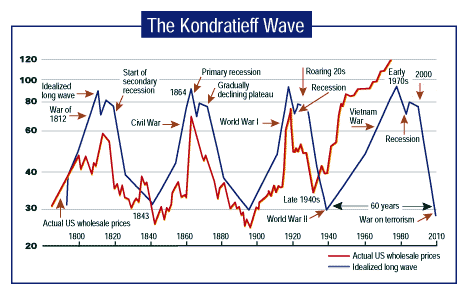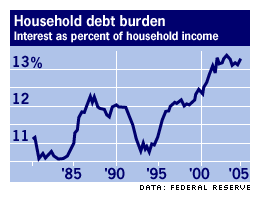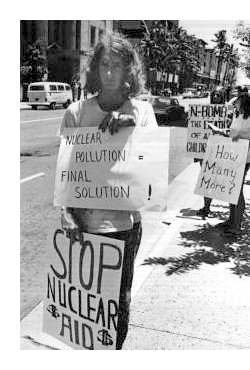

|
| weblog/wEssays | home | |
|
Are We Poised on the Precipice of Another Age of Turmoil? (June 2005) First, I want to take notice of D-Day, June 6, 1944, the battle which set the stage for the defeat of fascism in Europe. (Interestingly, the battle which turned the tide in the Pacific War occured at roughly the same date, June 3 - 7, off Midway Island, in 1942. U.S. planes destroyed four Japanese aircraft carriers and even more importantly, the cream of Japanese naval aviation. But that's another story.) As we consider a day 61 years ago, it calls to mind the broad sweep of history, and various cyclical patterns of history--those posited by Nicolai Kondratieff and Ralph Nelson Elliott. For starters, let's consider 1893, 1932 and 1974. Interestingly enough, those bottoms of financial panics or depressions seem to operate on about 40-year cycles. If there is indeed a pattern there, we should get a humdinger of a depression around 2012. 
Kondratieff posited that an economic cycle of debt buildup and repudiation repeats every 50-60 years. Given the enormous borrowing binge the world has gleefully embarked on during the past five years (M-3 expansion of around $2 trillion by some estimates, American homeowners tapping their equity to the tune of $1.6 trillion in new debt, Federal budget deficits on the order of $400 billion annually, etc.), it's difficult to dismiss Kondratieff's fundamental insight as entirely wrongheaded. 
Many in his camp believe we are entering the "winter" phase which will culminate in a collapse or repudiation of all that debt. It's something to consider, given one irrefutable fact: no economy runs up forever in a straight line of unending growth. "The low-interest-rate-fueled growth in the U.S. economy, says Robert Brusca, president of Fact and Opinion Research, has played out principally through reckless spending from refinanced real estate. "I'm convinced that people have taken this money and blown it on gewgaws and junk," he says. "We're basically borrowing money to support our consumption, and we are living well beyond our means."  These "long waves" seem to suggest a severe and long-lasting downturn
in the world economy is close at hand, based on the fundamental insight that the enormous mountains of
debt which have been accumulated must now be repudiated in order to set up the next cycle of growth.
These "long waves" seem to suggest a severe and long-lasting downturn
in the world economy is close at hand, based on the fundamental insight that the enormous mountains of
debt which have been accumulated must now be repudiated in order to set up the next cycle of growth.
The writer as radical hippie, circa early 70s (photo courtesy of Ian Lind) There is another eerily repetitive pattern of change which has occurred on 40-year cycles in the past century: one of social tumult and change. Consider the explosion of artistic freedoms in film and music of the 1920s, and the concurrent lifting of social constraints, and then note the similarity to the 1960s (ending either with the disasterous Rolling Stones concert at Altamont in 1969, or Watergate in 1974,depending on your taste in history). If the 40-year pattern holds, we are in the midst of, or at least entering, a similar decade of social turmoil. We could posit that the cycle began on Septemebr 11, 2001, ushering in a period not of artistic expression but of new constraints and paranoia. The rise of the religious right as a political force could be seen as the penumbra of the 1960s, just as the rise of a radically reactionary Islam could be seen as a reverse analog of the big-power Communist threat the U.S. faced in the 60s. Where the 60s were all about questioning the conformity which had dominated social and political life in the 1950s, this decade seems to be about reining in the chaos, both outside the national borders and within. A new "ownership" ethic has replaced the paternalistic state ideal of the 1960s, and each new excess in the popular culture (hideously violent Playstation games, crudely misogynist hip-hop music [I know, I know, not all of it is], "edgy" television "entertainment") is matched by a shrill new constraint (banning medical marijuana, stem cells, etc.). Even more troubling, the divide between the wealthy elites and the middle class is widening; as the economy stumbles toward breakdown, the wealth of the nation has flowed to the top 5% of citizenry. As the average Schmoe relentlessly taps his home equity to support a lavishly foolish "upper-middle class lifestyle" filled with the spiritual rot of gimcrack distractions and useless toys, (Wall Street Journal, May 17, 2005, "Lagging Behind the Wealthy, Many Use Debt to Catch Up") the real wealth of the nation aggregates in the elites' hands. As tax rates for the wealthiest plummet to all-time lows, medical insurance becomes a luxury for everyone not independently wealthy or employed by a government agency. The nation careens down the path of a fiscal policy of endless deficit, transferring whatever wealth remains in the hands on the young to the elderly via unsustainably expensive Medicare benefits, and yet the citizenry are strangely complacent, as if their internal compasses have been scrambled. The events of the decade ahead may provide a lodestone for the dazed American citizenry; as things fall apart, they may find their internal compasses re-set, and the distractions of consumerism less mesmerizing. Can it happen too soon? I think not. (For more, see What This Country Needs Is a... Good Recession) * * * copyright © 2005 Charles Hugh Smith. All rights reserved in all media. I would be honored if you linked this wEssay to your site, or printed a copy for your own use. * * * |
||
| weblog/wEssays | home |